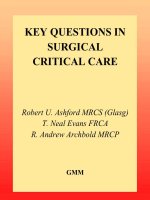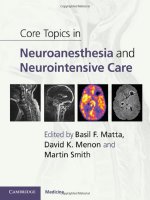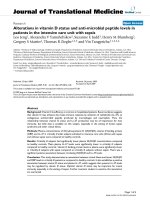key questions in surgical critical care
Bạn đang xem bản rút gọn của tài liệu. Xem và tải ngay bản đầy đủ của tài liệu tại đây (869.09 KB, 251 trang )
KEY QUESTIONS IN
SURGICAL
CRITICAL CARE
GMM
Robert U. Ashford MRCS (Glasg)
T. Neal Evans FRCA
R. Andrew Archbold MRCP
KEY QUESTIONS IN SURGICAL CRITICAL CARE
Kqs-FM.qxd 5/11/02 11:15 AM Page i
Kqs-FM.qxd 5/11/02 11:15 AM Page ii
This page intentionally left blank
KEY QUESTIONS IN SURGICAL
CRITICAL CARE
by
Mr Robert U. Ashford MRCS(Glasg)
Specialist Registrar in Trauma & Orthopaedics
York District Hospital
Yorkshire Deanery
UK
Dr T. Neal Evans FRCA
Specialist Registrar in Anaesthesia
Oxford Radcliffe Hospitals
Oxford Deanery
UK
Dr R. Andrew Archbold MRCP
Specialist Registrar in Cardiology
London Chest Hospital
London Deanery (North)
UK
London ♦ San Francisco
Kqs-FM.qxd 5/11/02 11:15 AM Page iii
www.greenwich-medical.co.uk
© 2003
Greenwich Medical Media Limited
137 Euston Road, London
NW1 2AA
870 Market Street, Ste 720
San Francisco, CA 94102
ISBN 1 84110 0927
First Published 2003
While the advice and information in this book is believed to be true and accurate, neither
the authors nor the publisher can accept any legal responsibility or liability for any loss or
damage arising from actions or decisions based in this book. The ultimate responsibility for
the treatment of patients and the interpretation lies with the medical practitioner. The
opinions expressed are those of the authors and the inclusion in this book of information
relating to a particular product, method or technique does not amount to an endorsement
of its value or quality, or of the claims made by its manufacturer. Every effort has been
made to check drug dosages; however, it is still possible that errors have occurred.
Furthermore, dosage schedules are constantly being revised and new side-effects recognised.
For these reasons, the medical practitioner is strongly urged to consult the drug companies'
printed instructions before administering any of the drugs mentioned in this book.
Apart from any fair dealing for the purposes of research or private study, or criticism or
review, as permitted under the UK Copyright Designs and Patents Act 1988, this publication
may not be reproduced, stored, or transmitted, in any form or by any means, without the
prior permission in writing of the publishers, or in the case of reprographic reproduction
only in accordance with the terms of the licences issued by the appropriate Reproduction
Rights Organisations outside the UK. Enquiries concerning reproduction outside the terms
stated here should be sent to the publishers at the London address printed above.
The rights of Robert Ashford, Neal Evans and Andrew Archbold to be identified as authors
of this Work have been asserted by them in accordance with the Copyright Designs and
Patents Act 1988.
The publisher makes no representation, express or implied, with regard to the accuracy of
the information contained in this book and cannot accept any legal responsibility or
liability for any errors or omissions that may be made.
A catalogue record for this book is available from the British Library.
Typeset by Mizpah Publishing Services, Chennai, India
Printed by The Alden Group Ltd, Oxford
Distributed by Plymbridge Distributors Ltd and
in the USA by Jamco Distribution
Kqs-FM.qxd 5/11/02 11:15 AM Page iv
vv
Contents
Preface vi
The Examination vii
List of Abbreviations ix
Acknowledgements xiii
Section 1 – MCQs
Cardiovascular System – Questions 3
Respiratory System – Questions 21
Other Systems and Multisystem Failure – Questions 36
Problems in Intensive Care – Questions 52
Principles of Intensive Care – Questions 55
Practical Procedures – Questions 61
Cardiovascular System – Answers 63
Respiratory System – Answers 90
Other Systems and Multisystem Failure – Answers 111
Problems in Intensive Care – Answers 130
Principles of Intensive Care – Answers 133
Practical Procedures – Answers 140
Section 2 – Vivas
Cardiovascular System – Questions 145
Respiratory System – Questions 147
Other Systems and Multisystem Failure – Questions 149
Problems in Intensive Care – Questions 151
Principles of Intensive Care – Questions 152
Practical Procedures – Questions 153
Cardiovascular System – Answers 155
Respiratory System – Answers 170
Other Systems and Multisystem Failure – Answers 202
Problems in Intensive Care – Answers 223
Principles of Intensive Care – Answers 225
Practical Procedures – Answers 230
Kqs-FM.qxd 5/11/02 11:15 AM Page v
vivi
Preface
Postgraduate surgical examinations take the form of multiple-choice
questions, viva voce examinations and clinicals. In all the Royal Colleges,
a key component of the first two of these sections is critical care. This
book is a companion to Surgical Critical Care, by Robert Ashford and
Neal Evans, published by Greenwich Medical Media Ltd in 2001, and
examines all aspects of the subject that may be assessed.
This book is split into two sections: multiple-choice questions and viva
topics. Based upon the syllabus of the Royal College of Surgeons of
England, each of these two sections is sub-divided into the same six
sections as Surgical Critical Care. Each answer is cross-referenced to
specific pages in Surgical Critical Care (using the icon) as well as
being elaborated upon.
The multiple-choice questions are of a multiple true/false type. Marking
should be in the form of the examination you are sitting. Remember
some of the Royal Colleges employ negative marking, which is designed
to prevent the candidate from guessing. The viva topics are questions
typical of those you may be asked in the examination.
This book does not aim to be a definitive textbook for the MRCS
examination. It is designed as a revision aid and to stimulate
self-assessment.
Good luck!
R.U.A.
T.N.E.
R.A.A.
October 2002
SCC
Kqs-FM.qxd 5/11/02 11:15 AM Page vi
viivii
The Examination
Whilst the Royal Colleges are working towards a unified MRCS
examination, this is not yet in place. The Royal Colleges therefore have
differing examination formats. Critical care is not specifically included in
the clinical section of the examinations, therefore this is not discussed.
As with all examinations, the format may change and candidates are
advised to check the latest regulations with the relevant college.
England – MRCS
Two MCQ Papers: Core and Systems. Each paper consists of 65 MCQs and
60 EMQs to be answered in two and a half hours. Critical care is tested
principally in Paper 1. Multiple true/false MCQs not negatively marked.
Three Viva Voce examinations each of 20 minutes: Anatomy, Physiology
and Pathology. 10 minutes of Basic Science and 10 minutes of Clinical
Surgery. Critical Care is examined for 10 minutes in the physiology viva.
Edinburgh – MRCS(Ed)
Two MCQ Papers: Core Syllabus and Systems Syllabus. Negatively marked.
Three Viva Voce examinations each of 20 minutes: Critical Care, Principles
of Surgery, Clinical Surgery & Pathology.
Glasgow – MRCS(Glasg)
Two MCQ Papers: Core and Systems. 2 hours for each paper. Each paper
is a combination of MCQs and EMQs. MCQs are multiple true/false and
not negatively marked. Both papers must be sat the first time of entry.
Two Viva Voce examinations covering: Applied Anatomy, Operative
Surgery & Principles of Surgery, Surgical Physiology & Critical Care and
Applied Pathology & Bacteriology. 30 minutes each divided into the two
sections. Critical Care forms a major part of the physiology viva.
Ireland – AFRCSI
Two MCQ Papers: Paper 1 is a Basic Sciences Paper: This is a true/false
paper, which is 2 hours long. There are 30 five-part questions: 10 each in
Anatomy, Physiology and Pathology. This paper will be negatively
marked. Paper 2 is the Clinical Surgery Paper: This is a 2-hour paper
consisting of 24 questions with 5 stems in each question. The second
paper will be non-negatively marked. Minimum pass rate is 60%.
The Viva Voce examination consists of three 20-minute orals. The subjects
are: Principles of Operative Surgery & Surgical Anatomy, Critical Care,
Kqs-FM.qxd 5/11/02 11:15 AM Page vii
Surgical Emergencies & Applied Physiology, Surgical Management
& Principles of Pathology. This College expects candidates to have a high
level of knowledge of basic sciences. Therefore, each of these orals will
include basic science examiners. Each marked out of 100, minimum to
pass 180 out of 300.
There are a number of conventional terms applied to the examinations.
These are outlined below:
Characteristic, predominantly, The feature is present in more than
reliably 90% of cases
Typically, frequently, The feature is present in more than
commonly, usually 60% of cases
Often, tends to The feature is present in more than
30% of cases
Similarly, for percentages, a precise figure (e.g. 2.5%) means exactly that,
whereas a round figure (e.g. 20%) allows a little either way (Ϯ5%).
As with all examinations, read the question properly.
viii
Kqs-FM.qxd 5/11/02 11:15 AM Page viii
List of Abbreviations
ABC Airway, Breathing and Circulation
ABE Actual base excess
ABG Arterial blood gas
ACE Angiotensin converting enzyme
ADH Anti-diuretic hormone
AF Atrial fibrillation
AHF Acute hepatic failure
AIS Abbreviated injury score
ALI Acute lung injury
ALS Advanced life support
AP Antero-posterior
APACHE Acute physiology and chronic health evaluation
APTT Activated partial thromboplastin time
ARDS Adult respiratory distress syndrome
ARF Acute renal failure
ATN Acute tubular necrosis
AXR Abdominal X-ray
BAE Bronchial artery embolisation
BLS Basic life support
BMI Body mass index
BMR Basal metabolic rate
BSD Brainstem death
BUN Blood urea nitrogen
CABG Coronary artery bypass grafting
CC Closing capacity
CKMB Creatinine kinase MB isoenzyme
CMV Controlled mandatory ventilation/Cytomegalo virus
CNS Central nervous system
CO Cardiac output
COHb Carboxyhaemoglobin
COPD Chronic obstructive pulmonary disease
CPAP Continuous positive airway pressure
CPB Cardiopulmonary bypass
CPP Cerebral perfusion pressure
CSF Cerebrospinal fluid
CT Computed tomography
CVP Central venous pressure
CVS Cardiovascular system
CXR Chest X-ray
DC Direct current
DIC Disseminated intravascular coagulation
DO
2
Oxygen delivery
ix
Kqs-FM.qxd 5/11/02 11:15 AM Page ix
DPG Diphosphoglycerate
DPL Diagnostic peritoneal lavage
DVT Deep vein thrombosis
EBV Epstein-Barr virus
ECF Extracellular fluid
ECG Electrocardiogram
EDRF Endothelium-derived relaxant factor
EDTA Ethylene diamintetraacetic acid
EEG Electroencephalogram
EJV External jugular vein
EMD Electromechanical dissociation
ERCP Endoscopic retrograde cholangio-pancreatogram
ERV Expiratory reserve volume
ESR Erythrocyte sedimentation rate
ETT Endo-tracheal tube
FBC Full blood count
FDP Fibrin degradation product
FES Fat embolism syndrome
FEV Forced expiratory volume
FFP Fresh frozen plasma
FRC Functional residual capacity
FVC Forced vital capacity
GCS Glasgow coma score
GFR Glomerular filtration rate
GIT Gastrointestinal tract
GTN Glyceryl trinitrate
HDU High dependency unit
HIV Human immunodeficiency virus
HPV Hypoxic pulmonary vasoconstriction
HR Heart rate
IABP Intra-aortic balloon pump
IAH Intra-abdominal hypertension
IAP Intra-abdominal pressure
ICF Intracellular fluid
ICP Intra-cranial pressure
ICU Intensive care unit
IJV Internal jugular vein
IL Interleukin
INR International normalised ratio
IOP Intra-optic pressure
IPPV Intermittent positive pressure ventilation
IRV Inspiratory reserve volume/Inverse ratio ventilation
ISS Injury severity scale
x
Kqs-FM.qxd 5/11/02 11:15 AM Page x
ITU Intensive therapy unit
IVC Inferior vena cava
JVP Jugular venous pressure
LD Lethal dose
LDH Lactate dehydrogenase
LFT Liver function test
LMA Laryngeal mask airway
LOC Loss of consciousness
LOS Lower oesophageal sphincter
MAP Mean arterial pressure
MAWP Mean airway pressure
MBP Mean blood pressure
MI Myocardial infarction
MODS Multi-organ dysfunction syndrome
MOF Multi-organ failure
MOFS Multi-organ failure syndrome
MRI Magnetic resonance imaging
MV Minute volume
NO Nitric oxide
NSAIDs Non-steroidal anti-inflammatory drugs
ODC Oxyhaemoglobin dissociation curve
ODP Operating department practioner
PAF Platelet activating factor
PAFC Pulmonary artery floatation catheter
PAH Para-amino hippuric acid
PAOP Pulmonary artery occlusion pressure
PAWP Peak airway pressure
PCA Patient controlled analgesia
PCV Pressure controlled ventilation
PE Pulmonary embolism
PEA Pulseless electrical activity
PEEP Positive end expiratory pressure
PEFR Peak expiratory flow rate
PEG Percutaneous gastrostomy
PEJ Percutaneous jejunostomy
PIFR Peak inspiratory flow rate
PS Pressure support
PSV Pressure support ventilation
PT Prothrombin time
PVR Pulmonary vascular resistance
xi
Kqs-FM.qxd 5/11/02 11:15 AM Page xi
RAA Renin-angiotensin-aldosterone
RBC Red blood cell
RDS Respiratory distress syndrome
RQ Respiratory quotient
RR Respiratory rate
RTS Revised trauma score
RV Residual volume
SBC Standard bicarbonate
SBE Standard base excess
SCV Subclavicular vein
SDH Subdural haematoma
SIADH Syndrome of inappropriate antidiuretic hormone
SIMV Synchronised intermittent mandatory ventilation
SIRS Systemic inflammatory response syndrome
SV Stroke volume
SVC Superior vena cava
SVR Systemic vascular resistance
TBSA Total body surface area
TIAE Tracheo-innominate artery erosion
TIPSS Transjugular intrahepatic portosystemic shunt
TLC Total lung capacity
TNF Tumour necrosis factor
TOE Transoesophageal echo/echocardiogram/echocardiography
TPN Total parenteral nutrition/Triphosphopyridine nucleotide
TRALI Transfusion related acute lung injury
TT Thrombin time
TTE Transthoracic echo
U&E Urea & Electrolytes
VC Vital capacity
VF Ventricular fibrillation
VSD Ventricular septal defect
VT Ventricular tachycardia
WCC White cell count
xii
Kqs-FM.qxd 5/11/02 11:15 AM Page xii
xiii
Acknowledgements
We wish to thank our families for their continuing support, and
Gavin Smith of Greenwich Medical Media for his patience and
encouragement in seeing the book through to press.
Kqs-FM.qxd 5/11/02 11:15 AM Page xiii
Kqs-FM.qxd 5/11/02 11:15 AM Page xiv
This page intentionally left blank
Section 1 – MCQs
Cardiovascular System – Questions 3
Respiratory System – Questions 21
Other Systems and Multisystem Failure – Questions 36
Problems in Intensive Care – Questions 52
Principles of Intensive Care – Questions 55
Practical Procedures – Questions 61
Cardiovascular System – Answers 63
Respiratory System – Answers 90
Other Systems and Multisystem Failure – Answers 111
Problems in Intensive Care – Answers 130
Principles of Intensive Care – Answers 133
Practical Procedures – Answers 140
Kqs-Q-s1-1.qxd 5/11/02 11:19 AM Page 1
Kqs-Q-s1-1.qxd 5/11/02 11:19 AM Page 2
This page intentionally left blank
1. Concerning the post-operative cardiac surgical patient:
A. Ventricular tachycardia (VT) is common
B. Temporary pacing is the treatment of choice for persisting
bradyarrhythmias
C. A loop diuretic (e.g. furosemide) is the next line of treatment
following an adequate fluid load in a patient with low urine
output
D. The incidence of discrete central nervous system (CNS)
damage is about 2%
E. Slow recovery of central temperature is suggestive of poor
cardiac output (CO)
2. Concerning cardiopulmonary bypass (CPB):
A. The optimal perfusion pressure is 120 mmHg
B. Venous cannulation is normally into the inferior vena cava
for closed procedures
C. The arterial cannula is usually inserted in the descending
aorta
D. The femoral artery is a recognised site for inserting the
arterial cannula
E. The patient is cooled to 25ЊC if circulatory arrest is
necessary
3. The following are commonly seen after coronary artery
bypass grafting (CABG):
A. Atrial arrhythmias
B. Basal lung collapse
C. Blood loss of approximately 250 ml in the first hour after
surgery
D. New Q waves on electrocardiogram (ECG)
E. Diffuse cerebral injury resulting in an alteration in short term
memory
Q
Q
Q
Key Questions in Surgical Critical Care
3
MCQs
Cardiovascular
System
Questions
Kqs-Q-s1-1.qxd 5/11/02 11:19 AM Page 3
4. Causes of poor cardiac output following cardiac surgery
include:
A. Poor myocardial function
B. Cardiac tamponade
C. Bleeding
D. Hypocapnia
E. Alkalosis
5. The following are indicators of poor peripheral
perfusion:
A. Hyperthermia
B. Oliguria
C. Confusion
D. Metabolic alkalosis
E. Central cyanosis
6. Heparin:
A. Increases formation of Antithrombin III – Thrombin
complex
B. Has a high lipid solubility
C. Is metabolised in the liver
D. May be used in the treatment of disseminated intravascular
coagulation (DIC)
E. May lead to hypotension
7. Pulmonary artery catheterisation:
A. Placement can be confirmed by a characteristic
waveform
B. Sepsis following catheterisation may lead to endocarditis
C. Is useful in septic shock
D. Wedging of the catheter is necessary in pulmonary
infarction
E. Cannot be done via peripheral veins
8. Norepinephrine (noradrenaline):
A. Acts mainly by ␣-1 adrenoceptors
B. Is excreted in the urine
C. Has a half life of approximately 2 minutes
Q
Q
Q
Q
Q
Key Questions in Surgical Critical Care
4
MCQs
Cardiovascular System
Questions
Kqs-Q-s1-1.qxd 5/11/02 11:19 AM Page 4
D. Reduces renal blood flow
E. May increase pulmonary vascular resistance
9. Dopamine:
A. At lower doses (Ͻ10 mcg/kg/min) increases contractility and
heart rate (HR)
B. Can increase cyclic AMP
C. Has predominantly -1 effects at higher doses
(Ͼ10 mcg/kg/min)
D. Is more arrhythmogenic than epinephrine (adrenaline)
E. Vasodilates mesenteric vessels
10. Concerning shock:
A. Pulmonary artery occlusion pressure (PAOP) is usually
increased in septic shock
B. Cardiac output is often decreased in hypovolaemic shock
C. Effective management of shock necessitates measurements
of both cardiac output and systemic vascular resistance
D. Blood pressure falls in septic shock
E. A urine output of 15 ml/hr is characteristic of class 1 shock
11. Concerning emboli:
A. 80% of systemic arterial emboli originate from the heart
B. 10 ml of gas injected is usually sufficient to cause significant
problems
C. Small pulmonary emboli can lead to right heart failure
D. Hypoxia 24 hours after a long bone fracture is likely to be
due to pulmonary embolus
E. Aortic thromboemboli usually have an impact in the cerebral
arterial system
12. Concerning vascular trauma:
A. Haemodynamic instability is an indication for urgent
angiography
B. Contrast computed tomography (CT) is useful for assessing
great vessel injury
C. Intimal injuries are the most common vascular injuries
Q
Q
Q
Q
Key Questions in Surgical Critical Care
5
MCQs
Cardiovascular System Questions
Kqs-Q-s1-1.qxd 5/11/02 11:19 AM Page 5
D. Shunting may be necessary for damage control
E. Packing is useful in controlling major arterial bleeds
13. Transfusion:
A. Transfusion related acute lung injury (TRALI) manifests itself
classically by severe dyspnoea
B. Graft versus host disease usually occurs within 24 hours
C. Management of WBC mediated transfusion reactions include
the immediate cessation of the transfusion
D. Leucodepletion reduces the risk of febrile reactions
E. Massive transfusion is defined as the transfusion of more
than half the blood volume in 24 hours
14. Haemorrhagic shock:
A. In class II shock the systolic BP is low
B. Class III shock is associated with a urine output of
approximately 10 ml per hour
C. Pulse pressure is decreased in class I shock
D. Class III shock is a loss of approximately 25% of the blood
volume
E. Confusion is indicative of class III shock
15. The following are causes of peri-operative arrhythmias:
A. Hypocapnia
B. Hypoxaemia
C. Pain
D. Myocardial infarction (MI)
E. Local anaesthetics
16. The following ECG changes are supportive for the
diagnosis of post-operative pulmonary embolus:
A. Right bundle branch block
B. T wave inversion in the anterior chest leads
C. Left axis deviation
D. Atrial fibrillation (AF)
E. Right ventricular strain
Q
Q
Q
Q
Key Questions in Surgical Critical Care
6
MCQs
Cardiovascular System
Questions
Kqs-Q-s1-1.qxd 5/11/02 11:19 AM Page 6
17. The following haematological parameters would raise
the suspicion of DIC:
A. Decreased platelets
B. Increased fibrinogen
C. Prolonged thrombin time
D. Decreased fibrin degradation products (FDP)
E. Profuse bleeding
18. Concerning intravenous fluids in the critically ill:
A. Approximately 20% of infused normal saline (0.9% NaCl)
remains intravascular
B. Hartmann’s solution (Ringer’s lactate) contains approximately
20 mmol/l potassium
C. Normal saline has a pH of 7.4
D. Hartmann’s solution is isotonic
E. Approximately 30% of infused 5% dextrose remains
intravascular
19. Concerning the post-operative cardiac surgical
patient:
A. VT is common
B. Temporary pacing is generally the treatment of choice for
persisting bradyarrhythmias
C. A loop diuretic (e.g. Furosemide) is the second line of
treatment, after ensuring adequate fluid load, for low urine
output
D. The incidence of discrete CNS damage is approximately 2%
E. Slow recovery of central temperature is suggestive of poor
cardiac output
20. The following are commonly seen after CABG:
A. Atrial arrhythmias
B. Basal lung collapse
C. Blood loss of 250 ml in the first post-operative hour
D. New Q waves on ECG
E. Diffuse cerebral injury leading to short term memory
alteration
Q
Q
Q
Q
Key Questions in Surgical Critical Care
7
MCQs
Cardiovascular System Questions
Kqs-Q-s1-1.qxd 5/11/02 11:19 AM Page 7
21. Causes of poor cardiac output following cardiac surgery
include:
A. Poor myocardial function
B. Cardiac tamponade
C. Bleeding
D. Hypocapnia
E. Alkalosis
22. Insertion of a pulmonary artery floatation catheter (PAFC)
enables the following:
A. Measurement of right side cardiac filling pressure
B. Measurement of left side cardiac filling pressure
C. Measurement of pulmonary artery pressure
D. Measurement of cardiac output
E. Measurement of core blood temperature
23. The following may cause pulseless electrical
activity (PEA):
A. Hypokalaemia
B. Hypocalcaemia
C. Open pneumothorax
D. Cardiac rupture
E. -blockers
24. Dopamine:
A. Stimulates cardiac -1 receptors
B. Has a most common complication of tachycardia
C. When it extravasates causes profound tissue damage
D. In low doses reduces serum prolactin
E. May worsen mesenteric perfusion at low doses
25. In septic shock:
A. Treatment should be with fluid therapy initially
B. Pulmonary artery floatation catheter is contra-indicated
C. Vasoactive agents can be useful
Q
Q
Q
Q
Q
Key Questions in Surgical Critical Care
8
MCQs
Cardiovascular System
Questions
Kqs-Q-s1-1.qxd 5/11/02 11:19 AM Page 8
D. Norepinephrine does not improve renal function
E. 10% of patients present with myocardial dysfunction
26. Cardiac output:
A. Is the volume of blood ejected from the left ventricle per
minute
B. Is proportional to stroke volume (SV)
C. Is inversely related to heart rate
D. Decreases as the filling pressure (preload) increases
E. Decreases as the systemic vascular resistance (afterload)
increases
27. The following statements regarding the circulation are
correct:
A. The total blood volume is about 5 litres
B. Only about 50% of the intravascular volume is distributed
in the systemic arterial circulation
C. Blood pressure ϭ cardiac output ϫ total peripheral resistance
D. In the normal heart, the blood volume is the main
determinant of central venous pressure (CVP)
E. A drop in blood pressure results in a reflex increase in heart
rate and vasoconstriction mediated by baroceptors in the
aorta and carotid sinus
28. Preload (filling pressure):
A. Is dependent upon volume status
B. Is reduced by venodilators
C. Is reduced by diuretics
D. Of the right heart can be measured by the CVP
E. Of the left heart can be measured by the PAOP
29. Afterload:
A. Is the myocardial wall tension developed during systole
B. Is inversely proportional to peripheral vascular resistance
C. Reduction decreases myocardial oxygen requirements
D. Reduction can increase the stroke volume
E. Reduction may increase coronary blood flow
Q
Q
Q
Q
Key Questions in Surgical Critical Care
9
MCQs
Cardiovascular System Questions
Kqs-Q-s1-1.qxd 5/11/02 11:19 AM Page 9
30. Tissue oxygen delivery increases with:
A. Cardiac output
B. Haemoglobin concentration
C. Haemoglobin saturation
D. Acidosis
E. Pyrexia
31. Myocardial contractility is reduced by:
A. Epinephrine (adrenaline)
B. Hypoxia
C. Dobutamine
D. Nitrates
E. -blockers
32. Physiological responses to heart failure include:
A. An increase in heart rate due to activation of the
parasympathetic nervous system
B. Activation of the renin-angiotensin-aldosterone
(RAA) system
C. Increased erythropoietin secretion
D. Peripheral vasodilatation
E. Increased sodium and water excretion
33. Cardiac failure:
A. May be defined as the failure of the heart to meet the
metabolic demands of the body at normal filling pressures
B. Is initially partially compensated through increased
myocardial muscle pre-stretching and myocardial contractility
(Starling’s law)
C. Is most commonly caused by ischaemic heart disease in
Western societies
D. Is usually associated with a low systemic vascular resistance
E. Is usually associated with a low PAOP
34. The CVP is typically elevated in:
A. Hypovolaemia
B. Congestive cardiac failure
Q
Q
Q
Q
Q
Key Questions in Surgical Critical Care
10
MCQs
Cardiovascular System
Questions
Kqs-Q-s1-1.qxd 5/11/02 11:19 AM Page 10









